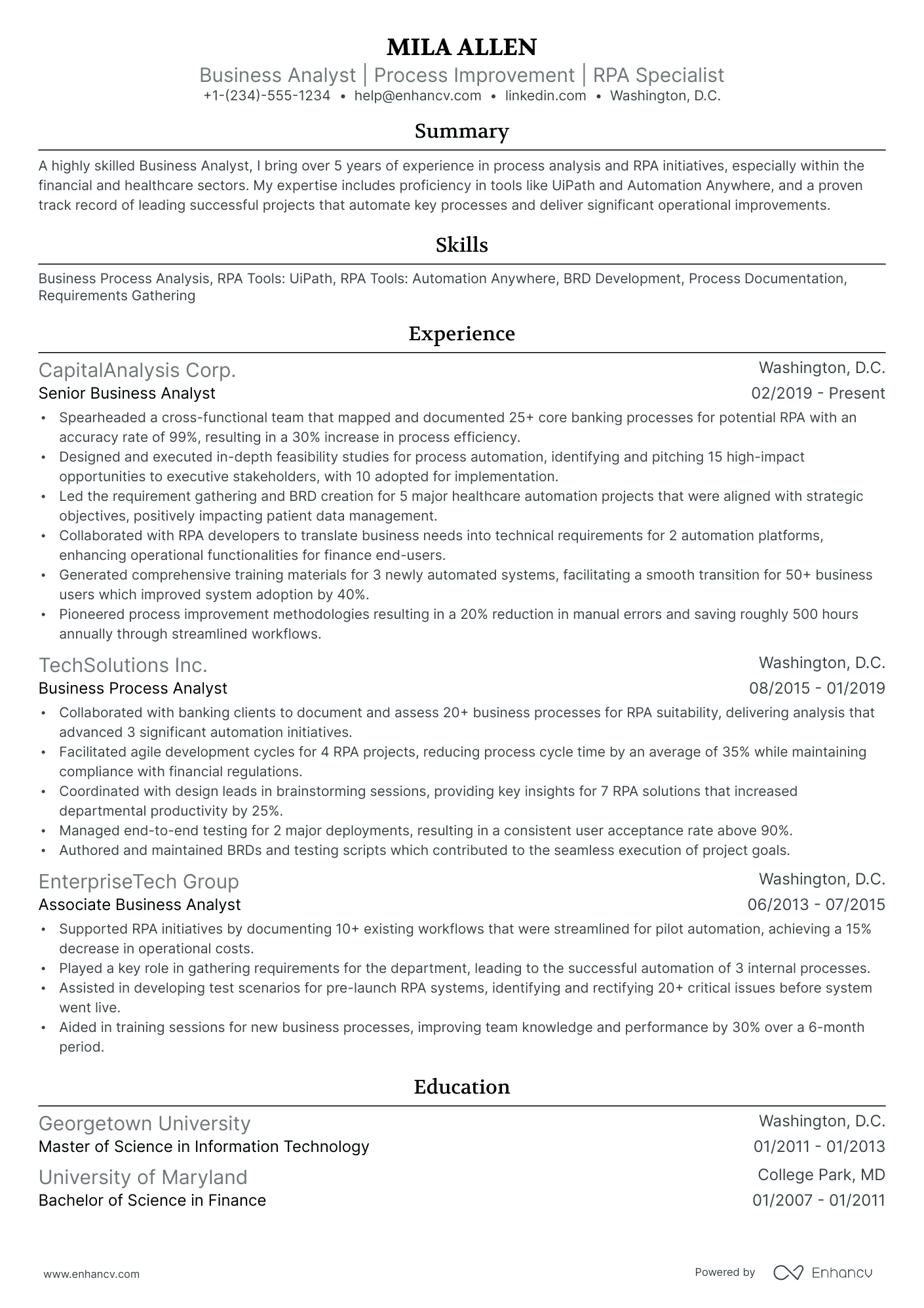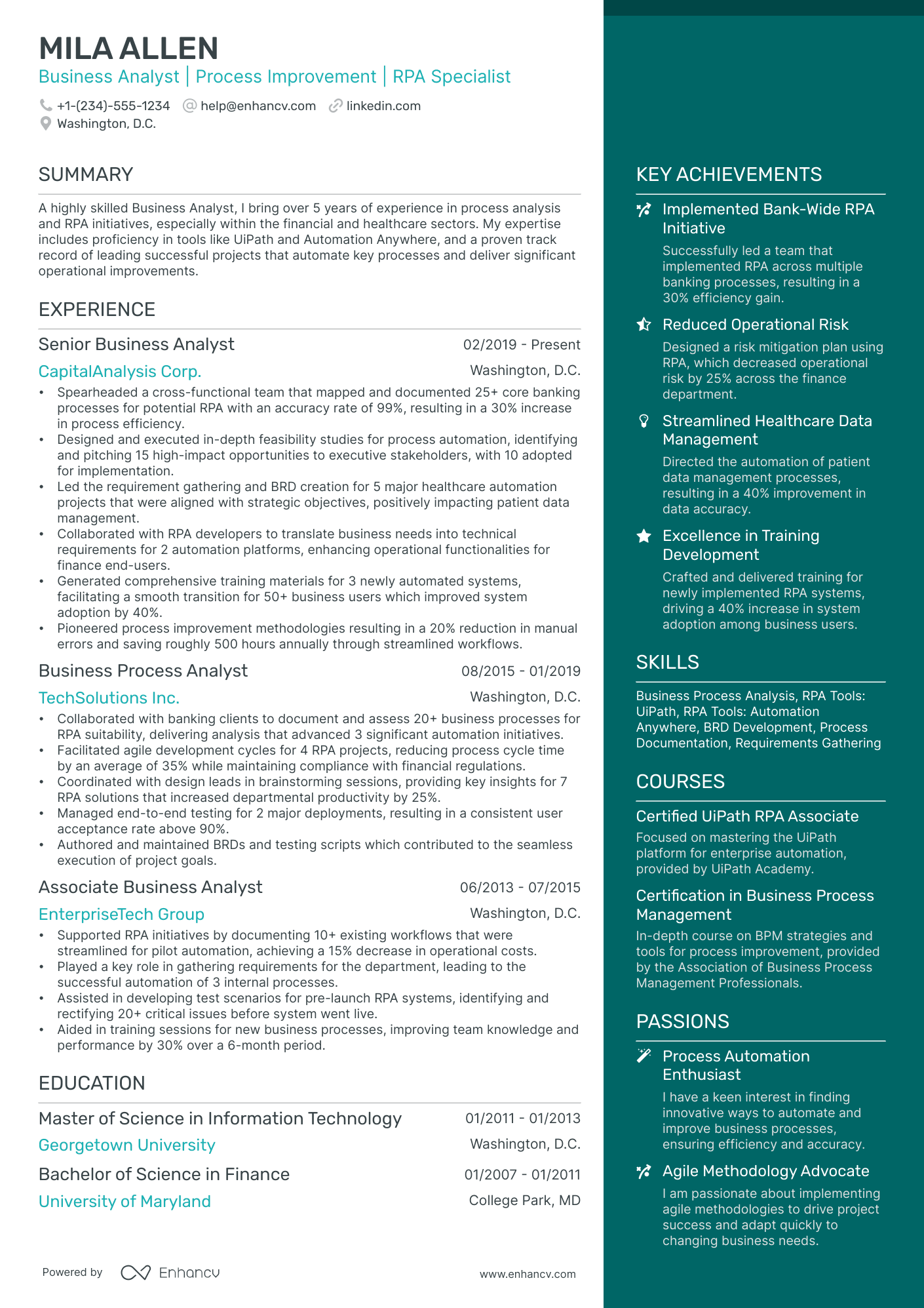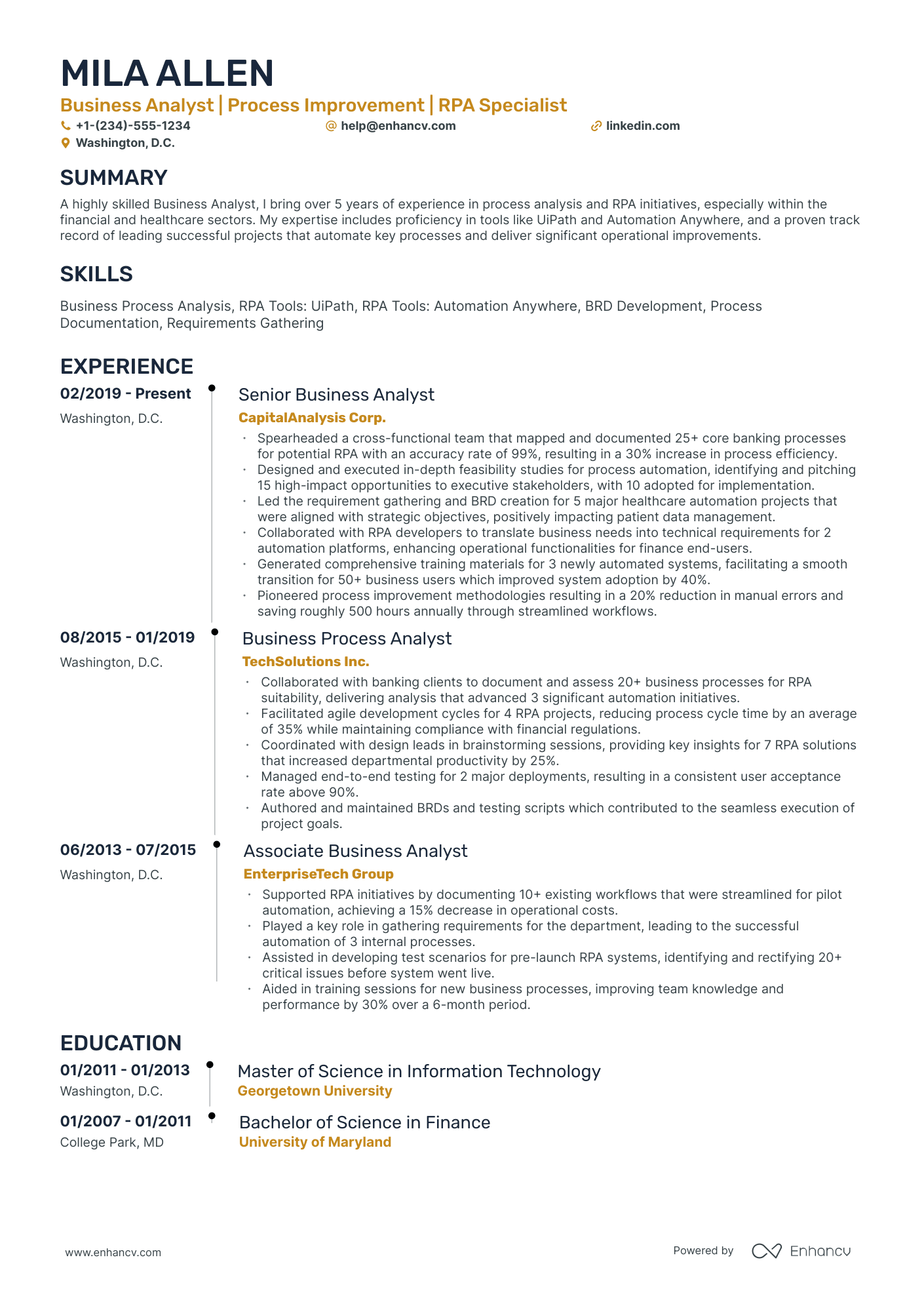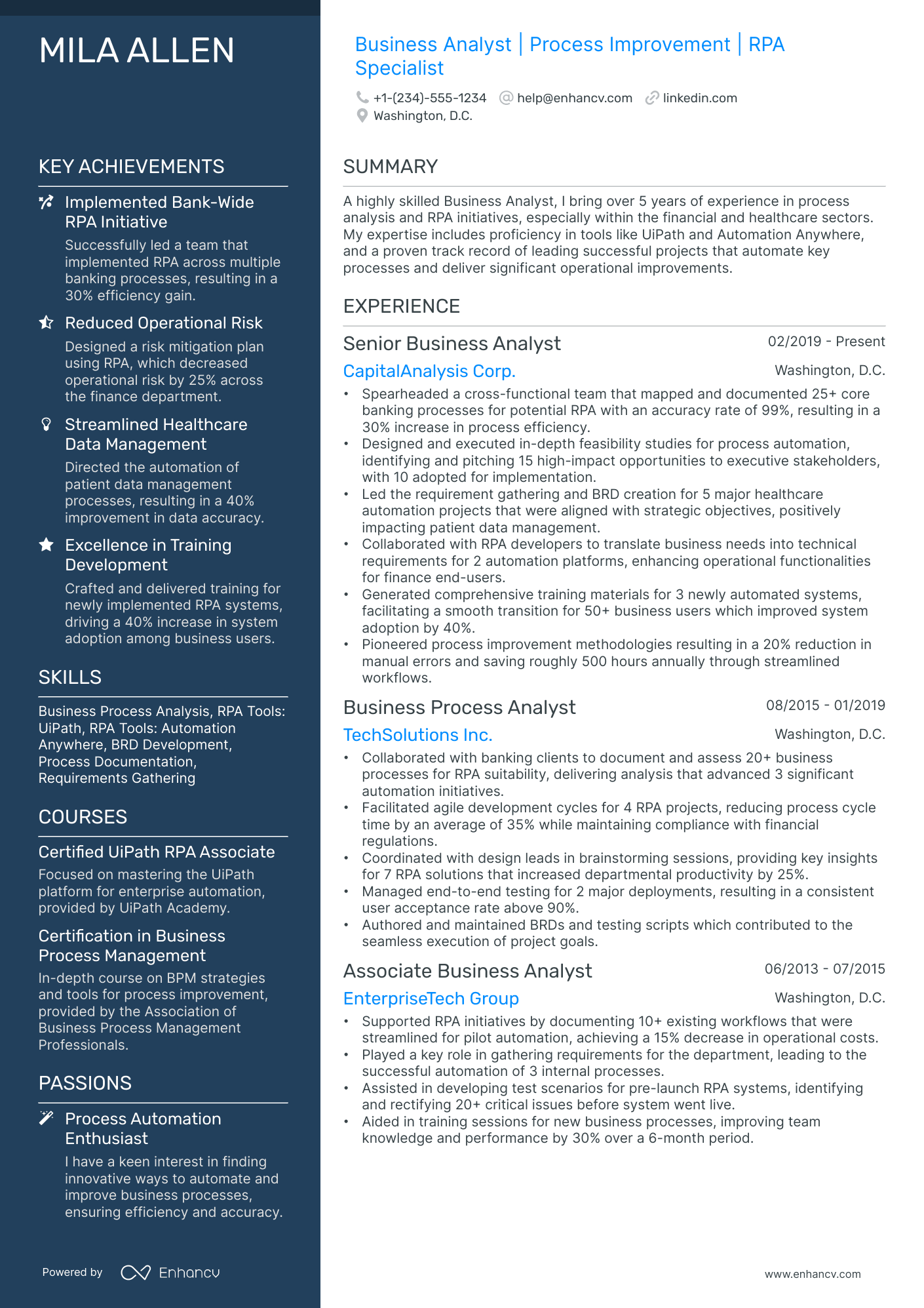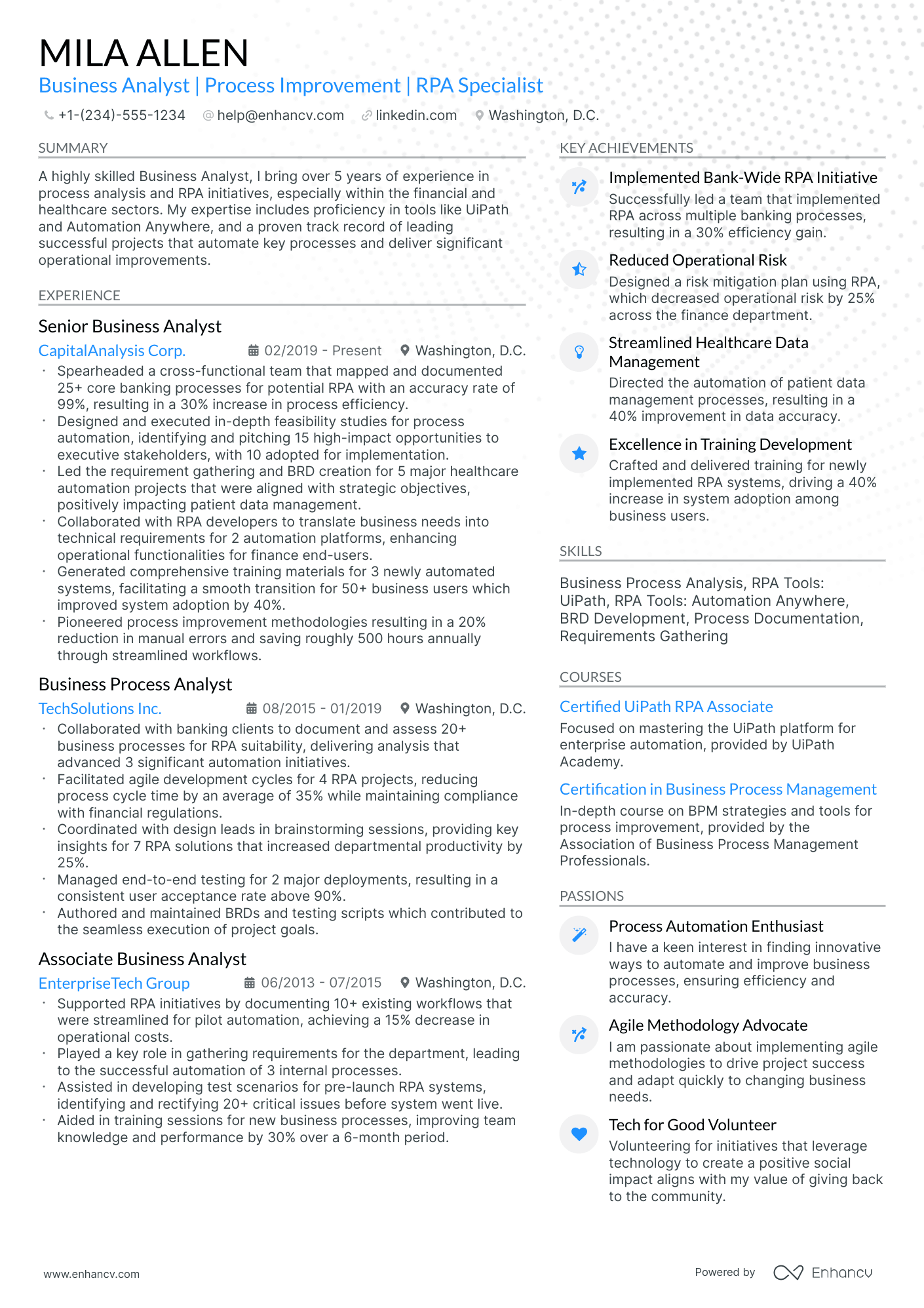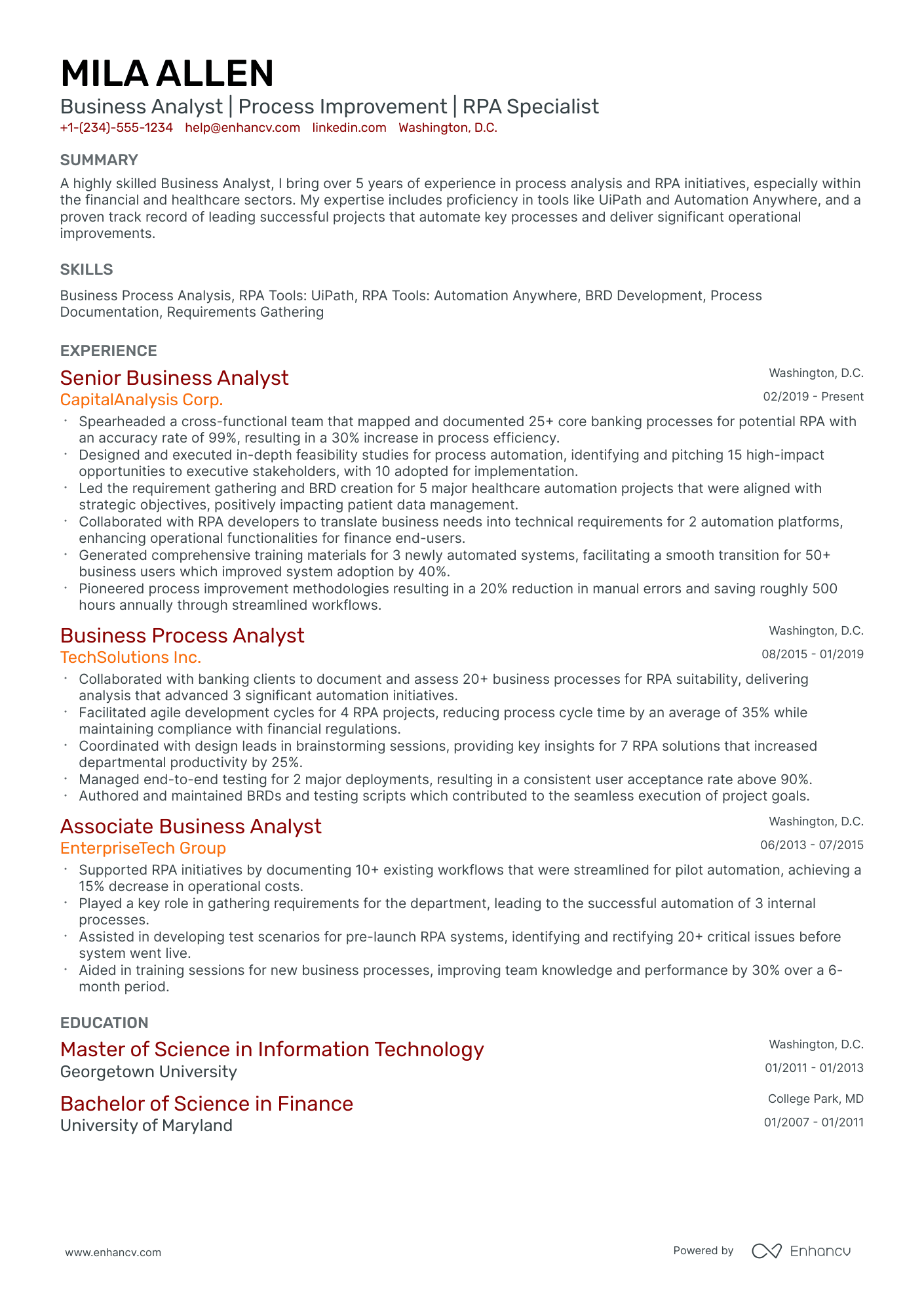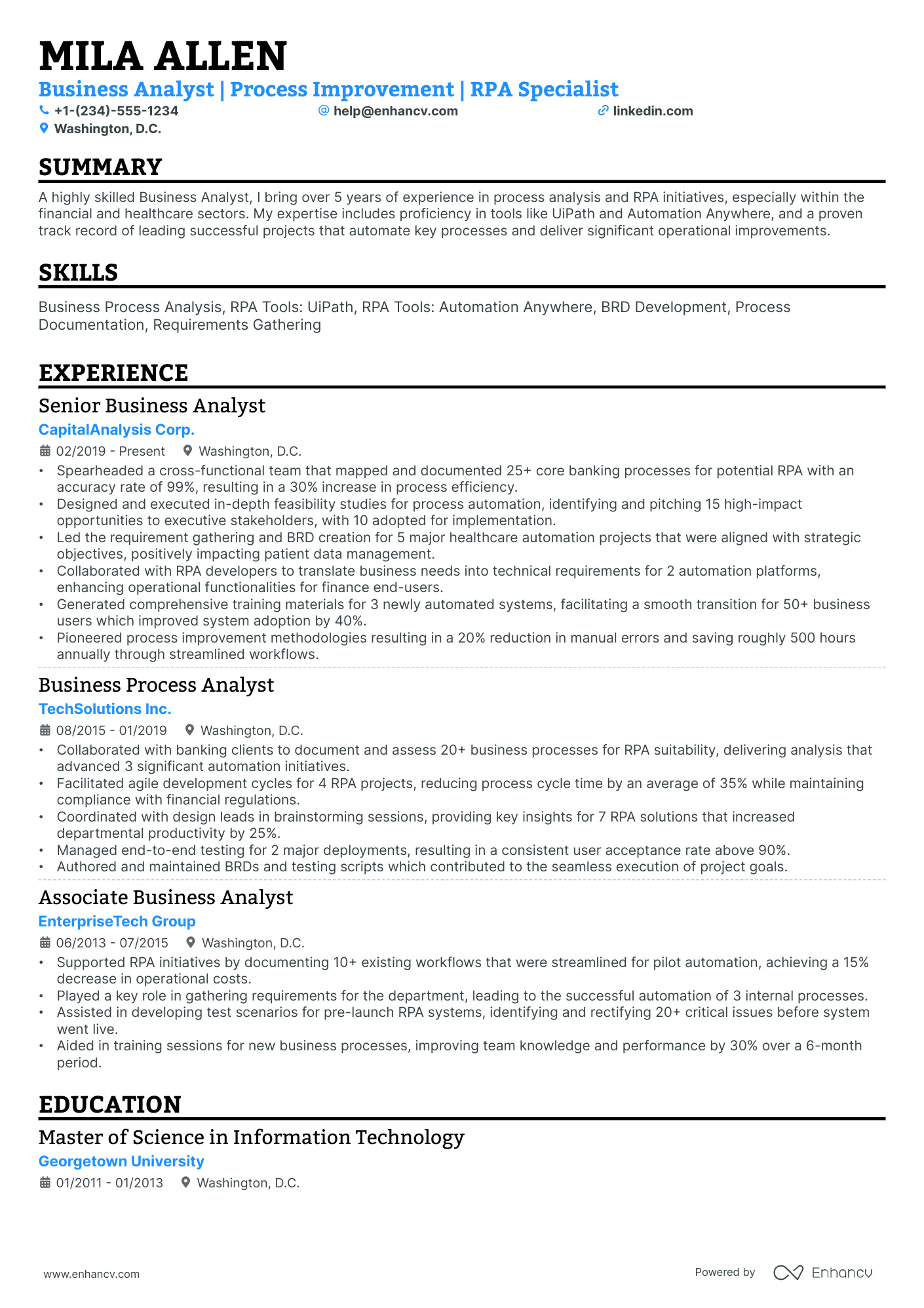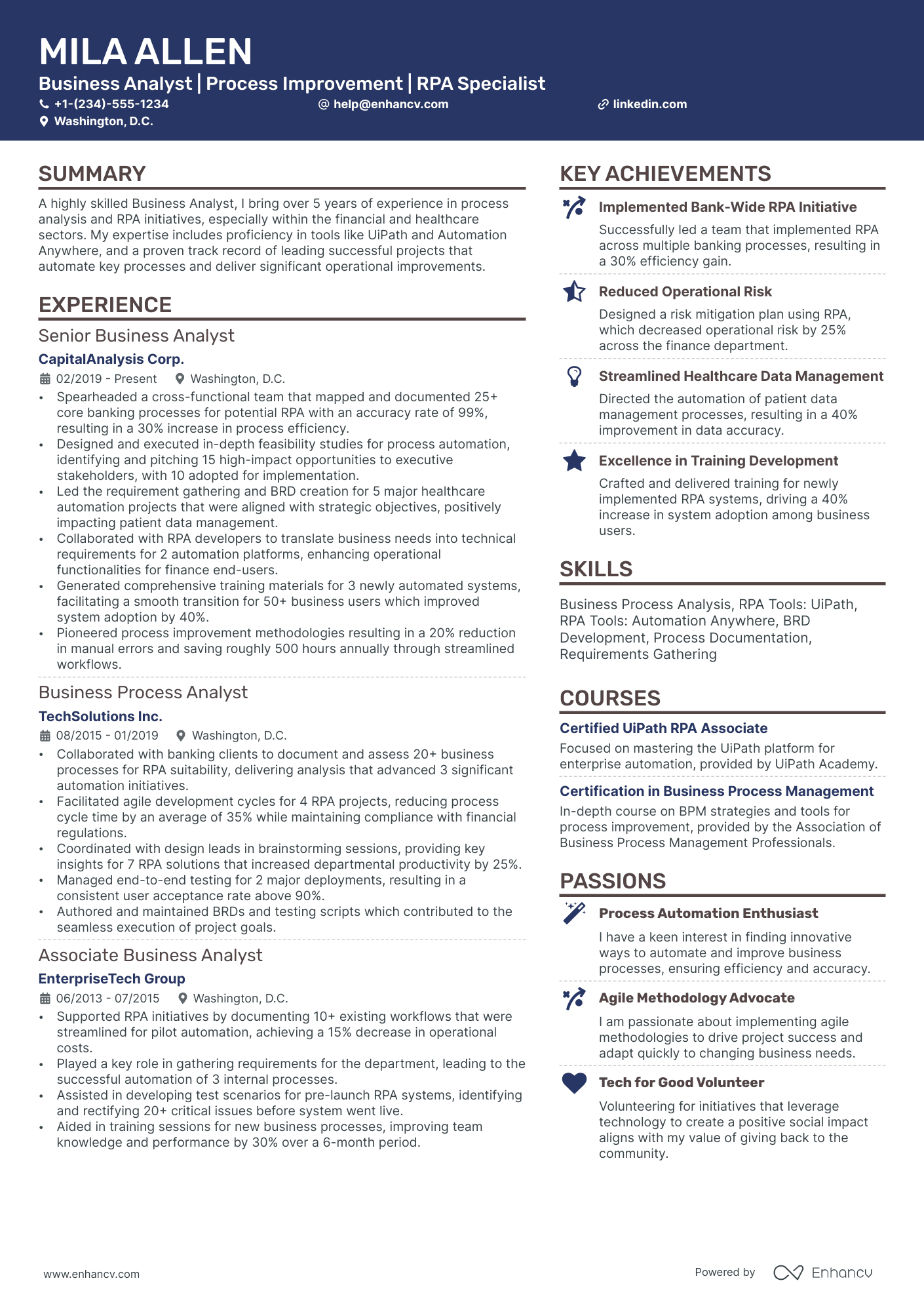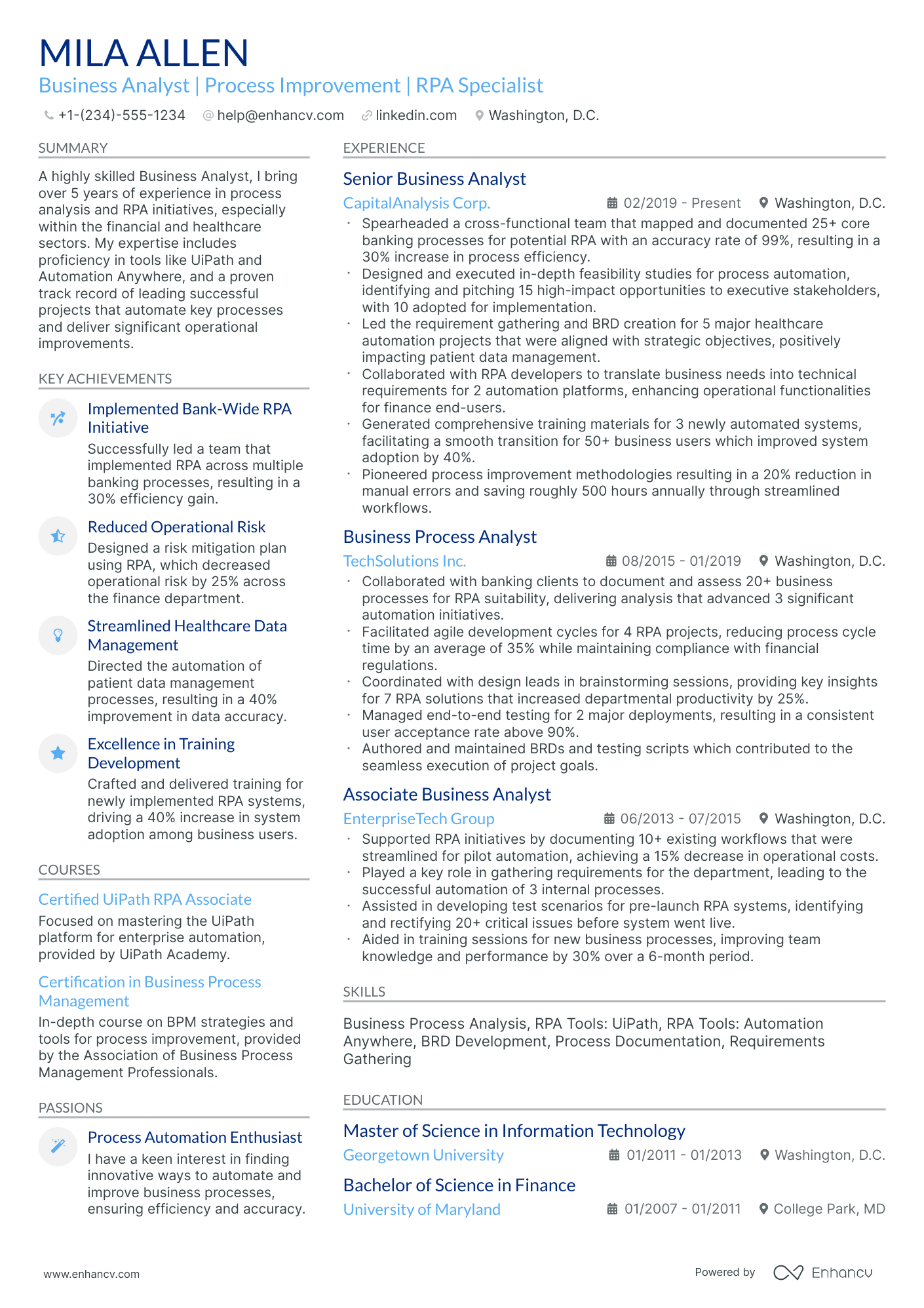As an RPA business analyst, you may struggle to capture the breadth of your automation expertise without overwhelming potential employers with jargon. Our guide steers you through the process of crafting a clear, impactful resume that communicates your skills and experience effectively to hiring managers.
- Incorporate RPA business analyst job advert keywords into key sections of your resume, such as the summary, header, and experience sections;
- Quantify your experience using achievements, certificates, and more in various RPA business analyst resume sections;
- Apply practical insights from real-life RPA business analyst resume examples to enhance your own profile;
- Choose the most effective RPA business analyst resume format to succeed in any evaluation process.
- Configuration Manager Resume Example
- Warehouse Operations Manager Resume Example
- Senior Business Analyst Resume Example
- Planning Manager Resume Example
- Business Director Resume Example
- Business Planning Manager Resume Example
- IT Business Analyst Resume Example
- Assistant Business Manager Resume Example
Don't stress out over your RPA business analyst resume format
Remember, the elaborate design of your RPA business analyst resume isn't what impresses recruiters most. They are primarily searching for candidates who meet the job requirements. The main aim of your resume should be to clearly and concisely explain why employers should hire you.
Here are four straightforward steps to consider in your RPA business analyst resume design:
- Organize your resume based on experience: Start with your most recent roles. Besides using reverse chronological order, choose jobs relevant to the position you're applying for.
- Include your contact details (and portfolio or LinkedIn link) in your resume's header to ensure recruiters can easily reach you. If considering adding a professional photo, check acceptable practices in different countries first.
- Don't omit essential RPA business analyst resume sections such as the summary or objective, experience, and education. These sections should reflect your career progression and align with job requirements.
- Maintain conciseness in your resume. For those with less than ten years of experience, a one-page format is advisable.
Regarding the format to submit your RPA business analyst resume, PDF is preferable. PDFs are more likely to maintain their formatting when processed through recruitment software or ATS, saving you time in the application process.
When selecting a font for your RPA business analyst resume, consider the following:
- Choose ATS-friendly fonts such as Exo 2, Volkhov, Lato, etc., to keep your resume's content legible;
- All serif and sans-serif fonts are easily readable by ATS;
- While Arial and Times New Roman are common choices, opting for unique typography can help your resume stand out.
Concerned about ATS compatibility with charts and infographics? Our recent study has debunked this and other myths.
Think about the market’s preferences – a Canadian resume, for instance, could have a different layout.
Upload & Check Your Resume
Drop your resume here or choose a file. PDF & DOCX only. Max 2MB file size.
PRO TIP
If you failed to obtain one of the certificates, as listed in the requirements, but decide to include it on your resume, make sure to include a note somewhere that you have the "relevant training, but are planning to re-take the exams". Support this statement with the actual date you're planning to be re-examined. Always be honest on your resume.
The key to your RPA business analyst job-winning resume - present your expertise with these sections:
- A header to make your resume more scannable
- Snapshot of who you are as a professional with your resume soft skills, achievements, and summary or objective
- Job advert keywords in the skills section of your resume
- Resume experience quantifying your past job successes with metrics
- A relevant education, certification, and technical sills section to provide background to your technological/software capabilities
What recruiters want to see on your resume:
- Understanding of RPA tools and technology (e.g., UiPath, Automation Anywhere, Blue Prism)
- Business process analysis and mapping
- Experience in designing RPA solutions and creating RPA project documentation
- Stakeholder management and requirement elicitation skills
- Experience in managing RPA projects and understanding of the RPA development lifecycle
Guide to your most impressive RPA business analyst resume experience section
When it comes to your resume experience , stick to these simple, yet effective five steps:
- Show how your experience is relevant by including your responsibility, skill used, and outcome/-s;
- Use individual bullets to answer how your experience aligns with the job requirements;
- Think of a way to demonstrate the tangible results of your success with stats, numbers, and/or percentages ;
- Always tailor the experience section to the RPA business analyst role you're applying for - this may sometimes include taking out irrelevant experience items;
- Highlight your best (and most relevant) achievements towards the top of each experience bullet.
You're not alone if you're struggling with curating your experience section. That's why we've prepared some professional, real-life RPA business analyst resume samples to show how to best write your experience section (and more).
- Led the discovery phase, identifying and quantifying automation opportunities, to streamline operations for the client's finance department, achieving a 30% increase in process efficiency.
- Developed comprehensive process documentation that included process flows and business logic, facilitating a smoother transition to the RPA solution for a project handling over 5,000 transactions monthly.
- Collaborated with IT stakeholders to ensure RPA solutions aligned with infrastructure and cybersecurity standards; this diligence reduced potential security vulnerabilities by 25%.
- Carried out cost-benefit analysis for proposed RPA initiatives, justifying a $1.2 million investment in automation technologies that yielded a 40% ROI within the first year.
- Managed a team of junior analysts and developers to deploy RPA bots, which processed over 10,000 invoices accurately per month, enhancing the accounts payable process.
- Spearheaded the implementation of a continuous improvement framework that resulted in a 15% reduction in bot maintenance efforts.
- Initiated and supervised the pilot RPA program that automated three key business processes, saving approximately 350 man-hours monthly.
- Conducted thorough business process analyses and presented findings to executive management which influenced the decision-making for strategic investments in automation.
- Partnered with the quality assurance team to implement best practice standards for RPA solutions, ensuring an error reduction rate of 20% for financial reporting.
- Facilitated stakeholder workshops to capture detailed business requirements, translating them into functional specifications for RPA solutions that expedited shipping procedures by 35%.
- Performed due diligence and risk analysis for potential RPA deployments, resulting in a balanced approach to automation with a keen eye on potential compliance issues.
- Provided training and mentorship to junior analysts, which was pivotal in building an in-house center of excellence for RPA development.
- Acted as the primary liaison between the business units and the RPA technical team, defining and refining business processes for an insurance client, elevating customer satisfaction by 20%.
- Developed detailed process maps and requirements specifications, contributing to the deployment of an RPA system that managed over 8,000 policyholder records per month.
- Analyzed post-deployment bot performance leading to an iterative optimization strategy that reduced bottlenecks by 45% over six months.
- Executed an RPA opportunity assessment for a telecom client, identifying key areas for automation that would lead to a savings of $500,000 annually.
- Coordinated the user acceptance testing (UAT) phase for newly developed bots, ensuring all automated processes met client expectations and operated within set parameters.
- Delivered thorough training sessions to business end-users on interacting with RPA bots, resulting in a productive transition period and minimal disruption to ongoing operations.
- Acted as RPA evangelist, conducting seminars and training sessions that raised awareness about the potential of RPA technologies, reaching an audience of over 500 employees.
- Guided the strategic rollout of RPA initiatives for a multinational banking client, automating 15 complex cross-departmental workflows and generating a time-savings of 2,000 hours per year.
- Implemented a tracking system that monitored bot performance and identified areas for improvement, leading to a 30% increase in bot productivity over 18 months.
- Orchestrated the successful integration of RPA solutions into customer service operations for a retail client, reducing average handle time by 25% across all inquiries.
- Authored comprehensive process documentation that served as the cornerstone for bot functionality, ensuring a high level of maintainability for longer-term RPA strategies.
- Designed a performance measurement framework to evaluate the effectiveness of RPA tools, contributing to an informed decision-making process for scaling operations.
- Provided expertise in RPA feasibility studies, uncovering five key processes within HR and procurement that were prime candidates for automation, leading to savings of 700+ hours per quarter.
- Crafted bespoke RPA solutions tailored to the nuances of client business models, enabling a smoother integration of automation technology into legacy systems.
- Drove cross-functional workshops to bridge the gap between technical teams and business stakeholders, ensuring seamless communication and alignment on project objectives.
- Assisted in the transformation of the enterprise supply chain through RPA, reducing order processing errors by 30% and improving supplier communication efficiency.
- Created a detailed RPA training curriculum and knowledge base, enabling the rapid onboarding of business users and fostering an agile response to market demands.
- Cultivated relationships with RPA software providers to stay abreast of the latest technologies, capitalizing on new features to drive process excellence.
Quantifying impact on your resume
- Include the exact percentage of process efficiency improvements achieved through RPA implementations.
- Quantify the time saved per process or project by implementing RPA solutions.
- Detail the amount of cost reduction achieved for the business through RPA initiatives.
- Specify the number of RPA bots developed and deployed to show project experience.
- Mention the volume of transactions or data processed by the RPA bots to demonstrate scalability.
- Highlight the increase in compliance rates post-RPA deployment to show risk management.
- Note the revenue growth or profitability increases resultant from RPA implementations.
- Document the reduction in error rates in business processes following RPA adoption.
Action verbs for your RPA business analyst resume
What to do if you don't have any experience
It's quite often that candidates without relevant work experience apply for a more entry-level role - and they end up getting hired.
Candidate resumes without experience have these four elements in common:
- Instead of listing their experience in reverse-chronological format (starting with the latest), they've selected a functional-skill-based format. In that way, RPA business analyst resumes become more focused on strengths and skills
- Transferrable skills - or ones obtained thanks to work and life experience - have become the core of the resume
- Within the objective, you'd find career achievements, the reason behind the application, and the unique value the candidate brings about to the specific role
- Candidate skills are selected to cover basic requirements, but also show any niche expertise.
Recommended reads:
PRO TIP
Mention specific courses or projects that are pertinent to the job you're applying for.
Balancing hard and soft skills in your RPA business analyst resume
Recruiters indeed pay close attention to the specific hard and soft skills candidates possess. Hard skills refer to technical abilities or your proficiency in technologies, while soft skills are the personal attributes and qualities developed over your lifetime.
If you're unsure about effectively quantifying these skills on your resume, follow our step-by-step guide. It's crucial to first understand the key job requirements for the role. Doing so enables you to accurately list your:
- Hard skills in sections like skills, education, and certifications. Your technical expertise is straightforward to quantify. Most organizations find it sufficient to mention the certificates you've earned, along with your proficiency level.
- Soft skills within your experience, achievements, strengths, etc. Defining interpersonal communication traits in your resume can be challenging. Focus on showcasing the accomplishments you've achieved through these skills.
Remember, when tailoring your RPA business analyst resume, ensure that the skills you list match exactly with those in the job requirements. For instance, if the job listing specifies "Microsoft Word," include this exact term rather than just "Word" or "MSO."
Top skills for your RPA business analyst resume:
UiPath
Automation Anywhere
Blue Prism
SQL
Python
Excel VBA
Power BI
Process Mapping
RPA Governance
Business Process Modeling
Analytical Thinking
Problem Solving
Communication
Collaboration
Attention to Detail
Adaptability
Critical Thinking
Time Management
Stakeholder Management
Requirements Gathering
PRO TIP
Showcase any ongoing or recent educational efforts to stay updated in your field.
Discover the perfect certification and education to list on your RPA business analyst resume
Value the insights your resume education section offers. It can shed light on various proficiencies and experiences tailored for the job.
- Add only college or university degrees, stating the institution and duration.
- If you're nearing the end of your degree, note your graduation date.
- Weigh the pros and cons of including unrelated degrees - it might not be your best choice with so little space on your resume.
- Talk about your educational achievements if they amplify your relevant experience.
There are so many certificates you can list on your resume.
Just which ones should make the cut?
- List your prominent higher education degree in a separate box, alongside the name of the institute you've obtained it from and your graduation dates
- Curate only relevant certificates that support your expertise, hard skills, and soft skills
- Certificates that are more niche (and rare) within the industry could be listed closer to the top. Also, this space could be dedicated to more recent certifications you've attained
- Add a description to your certificates or education, only if you deem this could further enhance your chances of showcasing your unique skill set
When listing your certificates, remember that it isn't a case of "the more, the merrier", but rather "the more applicable they are to the industry, the better".
Recruiters have hinted that these are some of the most in-demand certificates for RPA business analyst roles across the industry:
The top 5 certifications for your RPA business analyst resume:
- Certified Business Analysis Professional (CBAP) - International Institute of Business Analysis (IIBA)
- Agile Analysis Certification (IIBA-AAC) - International Institute of Business Analysis (IIBA)
- Certified Analytics Professional (CAP) - INFORMS
- Robotic Process Automation (RPA) Business Analyst Training - The RPA Academy
- Advanced Certificate in Robotic Process Automation - UiPath Academy
PRO TIP
The more time and effort you've put into obtaining the relevant certificate, the closer to the top it should be listed. This is especially important for more senior roles and if the company you're applying for is more forward-facing.
Recommended reads:
Writing the RPA business analyst resume summary or objective: achievements, keywords, dreams, and more
Deciding on whether to include a resume summary or resume objective should entirely depend on your career situation.
If you have:
- Plenty of relevant achievements you'd like to bring recruiters' focus to, make use of the resume summary. Ensure each of your achievements is quantified with concrete proof (e.g. % of cases solved).
- Less applicable experience, utilize the resume objective. Within the objective include a few noteworthy, past successes, followed up by your professional dreams.
As a bonus, you could define in either your RPA business analyst resume summary or objective what makes you the perfect candidate for the role.
Think about your unique hard and soft skills that would make your expertise even more important to the job.
These RPA business analyst professionals have completely covered the formula for the ideal resume introduction:
Resume summaries for a RPA business analyst job
- With over 8 years of experience in process automation, a seasoned RPA business analyst brings a proven track record of implementing efficient bot solutions, adept in UiPath and Blue Prism. Instrumental in automating ERPs across healthcare sectors, achieving a 40% increase in process efficiency.
- Dynamic financial professional pivoting to RPA Business Analysis, offers a decade of experience optimizing budgeting processes and a passion for technology. Excelled in Salesforce and QuickBooks integration projects, eager to replicate success in automating business systems using RPA tools.
- Former software developer with 5 years' experience, including mastery of Python and Java, now pursuing an RPA business analyst career. Spearheaded a successful internal tools automation project, catalyzing a 25% productivity uplift in software development lifecycle management. Eager to apply technical expertise and project management acumen in RPA.
- IT consultant with 6 years of experience seeks to transition to an RPA business analyst, bringing hands-on experience in process mapping and analytical problem-solving. Successfully optimized cross-functional workflows through strategic IT solutions and now keen to leverage this experience in RPA implementations.
- Eager to excel as an RPA business analyst, a fresh graduate with a degree in Information Systems and a certification in Automation Anywhere. Committed to leveraging academic knowledge and internship experience in data analytics to streamline operations and contribute to impactful automation projects.
- Driven to forge a career as an RPA business analyst, with a background in computer sciences, proactive in self-learning key RPA technologies. Seeks to employ excellent analytical and process-optimization skills honed during university research projects in a practical, results-oriented environment.
Optimize your resume summary and objective for ATS
Drop your resume here or choose a file.
PDF & DOCX only. Max 2MB file size.
More relevant sections for your RPA business analyst resume
Perhaps you feel that your current resume could make use of a few more details that could put your expertise and personality in the spotlight.
We recommend you add some of these sections for a memorable first impression on recruiters:
- Projects - you could also feature noteworthy ones you've done in your free time;
- Awards - showcasing the impact and recognition your work has across the industry;
- Volunteering - the social causes you care the most about and the soft skills they've helped you sustain and grow;
- Personality resume section - hobbies, interests, favorite quote/books, etc. could help recruiters gain an even better understanding of who you are.
Key takeaways
At the end of our guide, we'd like to remind you to:
- Invest in a simple, modern resume design that is ATS friendly and keeps your experience organized and legible;
- Avoid just listing your responsibilities in your experience section, but rather focus on quantifiable achievements;
- Always select resume sections that are relevant to the role and can answer job requirements. Sometimes your volunteering experience could bring more value than irrelevant work experience;
- Balance your technical background with your personality traits across various sections of your resume to hint at how much time employers would have to invest in training you and if your profile would be a good cultural fit to the organization;
- Include your academic background (in the form of your relevant higher education degrees and certifications) to show recruiters that you have the technical basics of the industry covered.
